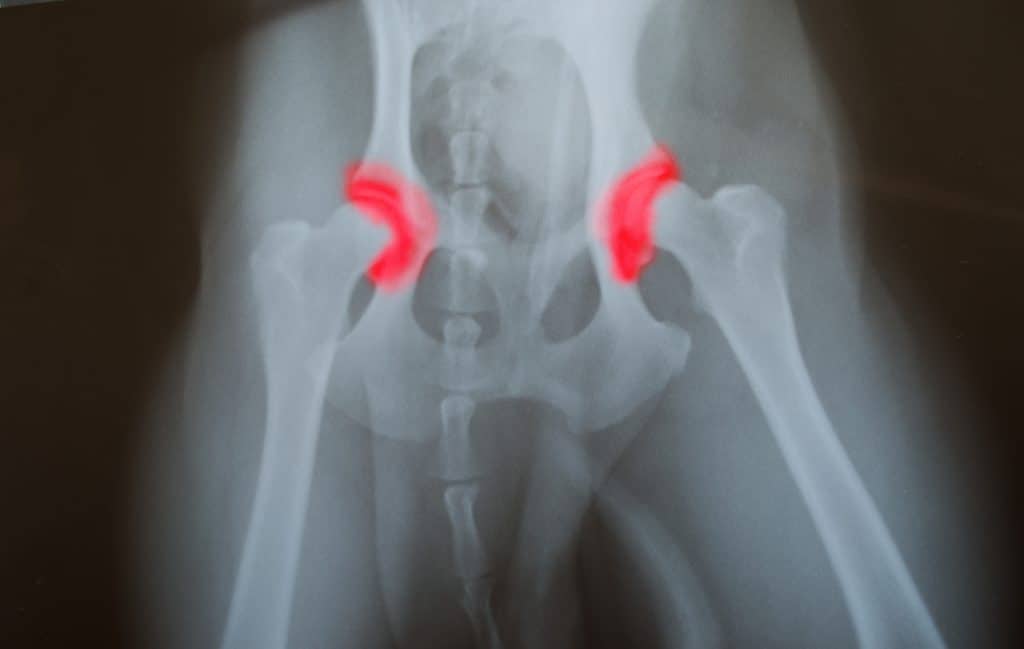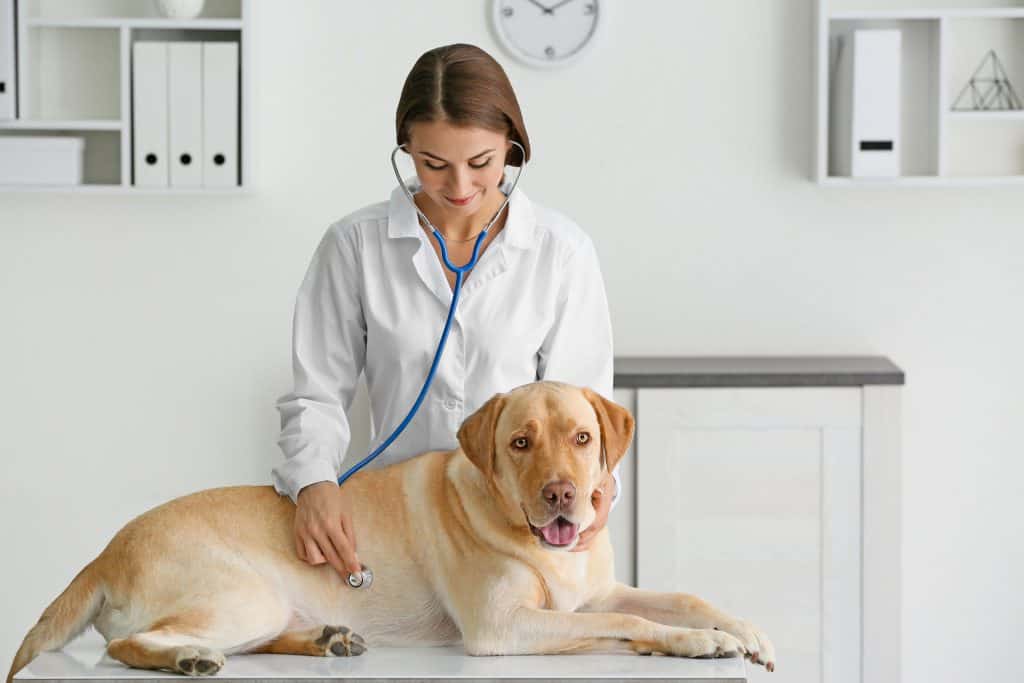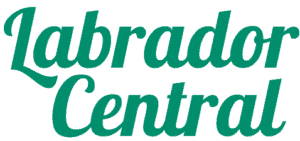- What is Elbow Dysplasia?
- What is Hip Dysplasia?
- How to Spot Elbow and Hip Dysplasia in Dogs
- Causes of Hip and Elbow Dysplasia
- Checking with your vet: Diagnosing Hip and Elbow Dysplasia
- Treatment for Hip and Elbow Dysplasia
- Are Labradors Prone to Hip and Elbow Dysplasia?
- How to Prevent Hip and Elbow Dysplasia in Dogs
- What's the Right Diet for Labrador Puppies?

While Labradors are one of the healthiest breeds, they can be prone to certain conditions. In particular, elbow and hip dysplasia. Which unfortunately are very common in Labrador Retrievers. This joint problem causes pain that begins in puppyhood and can continue as your dog ages. Although largely genetic, it is a preventable and treatable condition if you take the right steps.
Learn more about hip and elbow dysplasia in dogs including what causes it, how to diagnose it, how to prevent it, and how to treat it. Educating yourself on this topic while your Labrador is still a puppy is the best way to ensure your Lab’s health as it grows up.

What is Elbow Dysplasia?
Elbow dysplasia in dogs is a common joint condition in large dogs like Labradors. It occurs when the bones that make up the elbow joints do not develop properly and the elbow cannot move correctly, causing difficulty in movement and pain when walking.
The elbows are the joints of the front legs and it’s where the humerus (the bone in the upper leg) meets the radius and the ulna (the bones in the lower leg). If one or more of these bones do not develop correctly, that is, it grows more or less than it should, and the elbow joint will not be able to function properly.
Elbow dysplasia is related to osteochondrosis, which is a disease that occurs within cartilage in the joints. It is also related to a condition called osteochondritis dissecans, which is when a flap in the cartilage becomes separated. These conditions, while closely linked, can be difficult to identify and distinguish from one another. Your vet will identify the correct joint problem and help you to treat your dog back to full health.
What is Hip Dysplasia?
Like elbow dysplasia, hip dysplasia in dogs is caused by abnormal formations occurring during the growth stage of a puppy’s life. To maintain full health, both the ball and the socket joints in the pelvis have to grow at the same speed. Sometimes, this doesn’t occur, with one growing more quickly than the other. This leads to hip dysplasia.
Hip dysplasia, as well as elbow dysplasia, is caused by genetic factors. This means that it occurs more often in certain breeds of dogs, particularly medium and large breeds. Due to this fact, hip dysplasia in Labradors is very common. The condition isn’t entirely inherited, though, and could be made worse by environmental factors, like obesity. If left untreated, hip dysplasia in dogs can lead to arthritis and even lameness.
How to Spot Elbow and Hip Dysplasia in Dogs
Although hip and elbow dysplasia in dogs are different conditions, many of the symptoms will be the same. The main difference you’ll notice is whether it’s your Labrador’s elbow joints or hip that is causing discomfort. Beyond this, your dog may be showing some or all of the following symptoms:
- Becoming less active: Your dog may move less than before. They’d rather stay in one place than follow you obsessively around the house like they used to.
- Reluctance to perform activities: When you ask your dog to come, it may show a reluctance to run towards you. Perhaps it finds a way to walk around an obstacle where previously, they’d have jumped over it.
- Loose joints: Your dog may not be putting their full weight on one of its legs. Instead, they hold it loosely.
- A strange walk: The dog may move both back legs at once in an attempt to ease pressure or otherwise walk in an unusual fashion.
- A strange stance: When standing still, your dog’s legs might be very close together. One leg may even slide underneath the other one instead of standing strongly apart.
- Decreased muscle mass: the legs and thighs may be becoming thinner and less muscly as a result of your dog exercising less.
- Whining: The classic sign of pain. If your dog makes whining noises when walking, then it may have dysplasia.
- Dislocated joint: If the elbows or hip joints become dislocated, then this is a good sign of dysplasia.
- Fewer motions: Your dog may be walking fine but they aren’t able to twist, turn, and jump like it used to
- Lameness: In particular, your dog’s hind legs may go lame as a result of hip dysplasia.
- Stiffness: When your dog’s been laying down for a while, how long does it take them to stand up? If it takes some time, they may be feeling stiff.
When it comes to elbow and hip dysplasia in dogs, symptoms will start mild and become more severe over time. While the condition begins as a puppy, you usually won’t notice symptoms until your Labrador is around two years old. If you spot any abnormalities, monitor them closely to see if symptoms worsen. If they do, get your dog to the vet sooner rather than later to find a solution.

Causes of Hip and Elbow Dysplasia
Hip and elbow dysplasia in dogs have been proven to be linked to certain breeds. In particular, large breeds are significantly more likely than smaller breeds to develop these conditions. However, genetic factors aren’t everything. According to a study by the University of California’s Davis School of Veterinary Medicine, by neutering a large dog before the age of one year, you’re tripling its risk of developing hip or elbow dysplasia.
Furthermore, overweight dogs are more likely to suffer joint problems. In some cases, hip and elbow dysplasia in dogs is made worse by an injury. Keep your dog healthy and active to lower the chances of dysplasia developing. If they do get injured, ensure they have plenty of rest and time to recover fully.
Checking with your vet: Diagnosing Hip and Elbow Dysplasia
It may be that you suspect that your Labrador is showing symptoms of dysplasia in the elbows or hips, but you won’t know for sure. Take your pet to a vet to get them properly checked over. Using radiography, arthroscopy, X-rays, or computed tomography, the vet will be able to look at the hip and elbow joints more closely. They’ll then be able to diagnose the condition with accuracy. They’ll also categorize exactly which type of dysplasia your dog is experiencing.
Treatment for Hip and Elbow Dysplasia
Hip and elbow dysplasia in dogs cannot be fully cured but you can still alleviate the symptoms to ensure your Labrador has a happy life. In most cases, the owner will be able to do home therapy to keep the dog in shape. Painkillers can then be used for days when a dog is suffering allowing the dog to walk without too much discomfort. Through exercise and dietary supplements, weight can be kept down to ease the pressure on joints. Anti-inflammatory medication can also keep the condition at bay.
In more serious cases, surgery may be necessary. Joints can be replaced with a joint prosthesis, which restores most of the motion, and eliminates much of the pain. Bone plates can be inserted into the pelvis to increase stability. Alternatively, a full hip or elbow replacement restores complete mobility while also removing all the pain. This may be necessary for severe conditions and has a very high success rate. Talk to your vet first, though, because a diet and exercise routine may be enough to eliminate symptoms. Related: Benefits Of CBD Oil For Labrador Retrievers

Are Labradors Prone to Hip and Elbow Dysplasia?
All dogs can develop hip and elbow dysplasia but it particularly affects medium and larger breeds. Most notably, Rottweilers, German Shepherds, and Newfoundlands are prone to suffering from dysplasia. However, among the most likely to be affected are also Retrievers, which include Golden Retrievers, and Labrador Retrievers. That makes elbow and hip dysplasia in Labradors particularly common. While pug owners have to worry more about breathing problems and less about dysplasia, Labrador owners should keep their eyes open for any joint complaints.
Related post: Signs of Arthritis in a Dog
How to Prevent Hip and Elbow Dysplasia in Dogs
For many dogs, hip and elbow dysplasia is inevitable. However, even if this is the case, it will be minimized or exacerbated by lifestyle choices. How you choose to raise your Labrador will determine the severity of their joint pain and may prevent hip and elbow dysplasia entirely.
Try the following preventative measures to prevent elbow and hip dysplasia in Labradors:
- Keeping weight down: With a larger breed like Labradors, the joints can struggle under heavy body weight. Weigh your dog monthly and ensure it remains in a healthy weight range. This is 25kg to 32kg for a female or 29kg to 36kg for a male. Minimizing weight eases much of the pressure in the joints and therefore decreases pain.
- Dietary requirements: You can use supplements to increase your dog’s consumption of nutrients that promote healthy joints. The most important is omega 3 which is great for limiting inflammation. Glucosamine can also be used to speed up the recovery of damaged joints. This is a good solution following an injury. Finally, vitamin C increases collagen which can replace lost or damaged cartilage in the joints.
- Regular massage: Gently massaging the leg, thigh, and hip muscles can release tension build-up and help to relieve any soreness that could develop into dysplasia.
Hip and elbow dysplasia in dogs may not be entirely avoidable but you can lower your Labrador’s risk by following the tips listed above. Even if dysplasia does develop, symptoms will be less severe if you have a lighter Labrador who is getting the right nutrition. Related: Why Labradors Eat So Much?

Related Post: Labrador Retriever Puppy Feeding Guide
What’s the Right Diet for Labrador Puppies?
When it comes to Labradors, diets are so important. In particular, you need to ensure that puppies are receiving the right nutrition to promote healthy joints and lower the risk of dysplasia developing as they grow into full adults. Once they’ve moved off of puppy food and are eating proper meals, here’s what to keep in mind:
- Amount: While a 2 to 4-month-old Labrador puppy should be having four meals a day, 4 to 6-month-olds should have three meals, and 6 to 12-month-olds should have two meals. Meanwhile, food quantities should increase from 200 ounces a day to 250, and finally to 350. This is the lower end of the spectrum to ensure a Labrador that is as light as possible while still being healthy. If they look too skinny, then give your puppy slightly larger portions
- Proteins: For healthy joints and muscles as well as faster recovery from injury, protein is essential. Ensure it makes up between 25 and 30% of your puppy’s diet.
- Fats: Another 25% of your food should be fats but make sure it’s high quality. Omega 3 and fatty acids found in fish oil can help to reduce inflammation in the joints.
- Carbohydrates: For Labrador puppies, carbs are important but should be minimized. Keep their diet down to around 10% carbohydrates for optimal health. Starchy vegetables are great because they’re full of fiber and prevent weight gain.
- Vitamins: As discussed above, Labrador puppies need plenty of vitamins and minerals. B12 will promote healthy growth, while Vitamin D, iron, phosphorus, and calcium keep bones and joints strong.
Although very common, hip and elbow dysplasia can cause severe pain and discomfort for your Labrador. Give them the best chances of growing up happy by learning to spot the signs, take preventative measures, and alleviate the symptoms.
If you want to find the best pet insurance for your labrador, click here
Reference Links

